This post may contain affiliate links. Please read our disclosure policy.
Sauteed Napa Cabbage with Shiitake is a gem you won’t want to miss! This easy-to-make side dish combines the sweet and savory flavors of Napa cabbage with the rich umami of shiitake mushrooms, all brought to life with a hint of garlic and ginger.
Ready in just 20 minutes, it’s the perfect vegetarian-friendly stir fry for a busy weeknight. And don’t forget to check out my Chicken Napa cabbage stir fry. It’s another fan favorite!
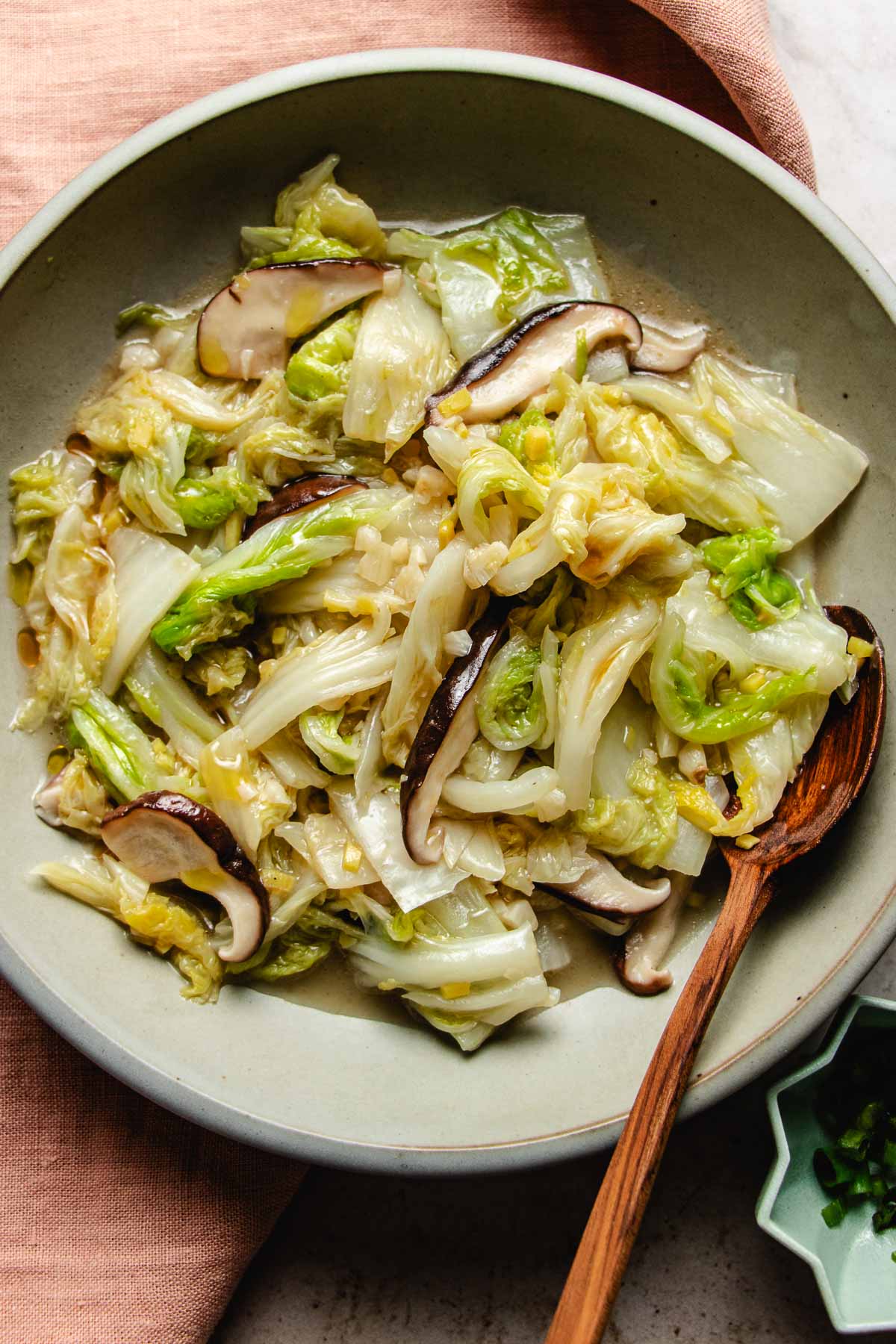
Table of Contents
Ingredients
Napa cabbage stir fry is all about simplicity and flavor. It’s my go-to side dish for those days when I’m craving something sweet and savory. Here’s what you’ll need to whip up this delightful dish:
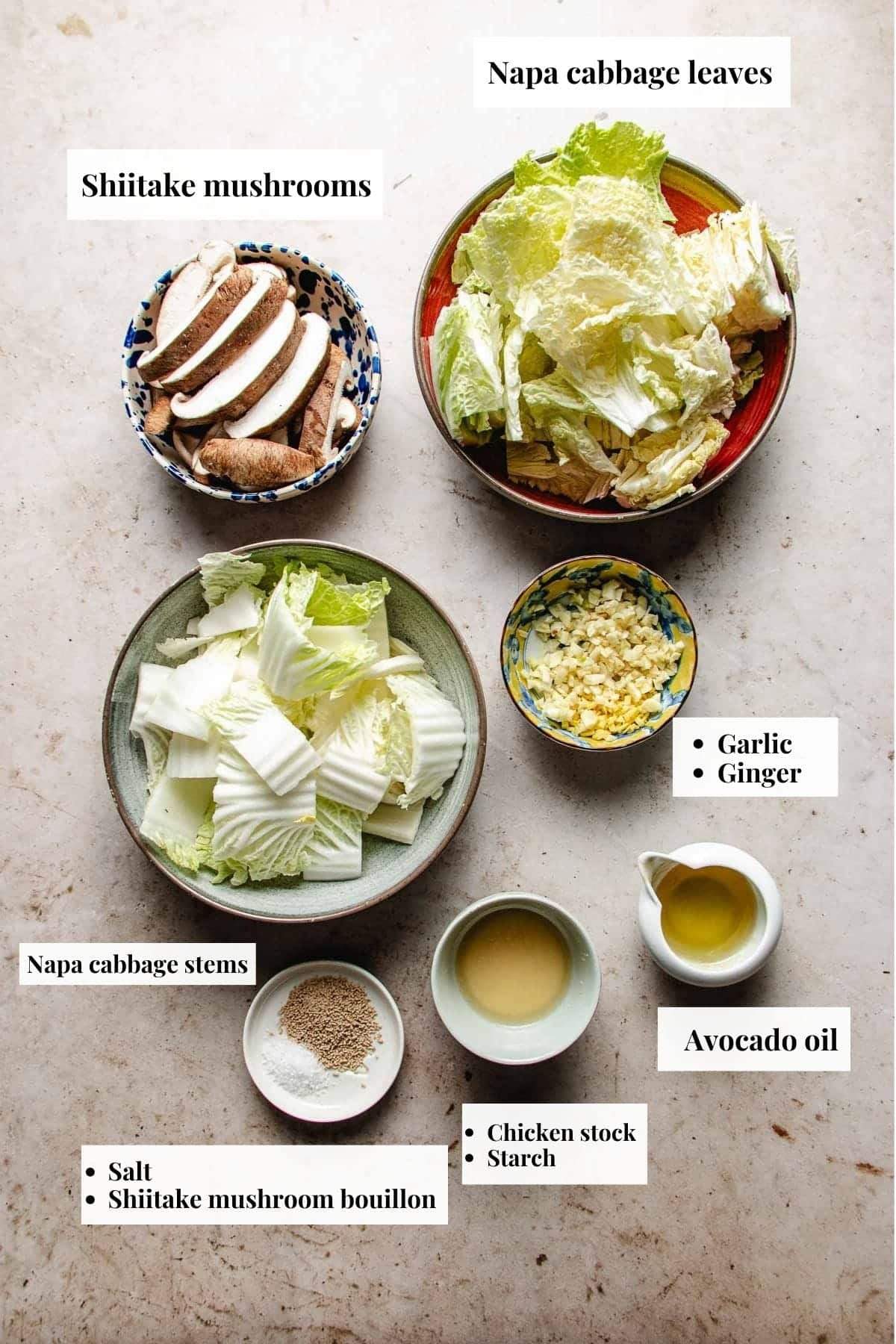
Save This Recipe
- Napa cabbage: Also known as Chinese cabbage, this key ingredient is chosen for its juicy, higher water content compared to other cabbages, providing a crisp texture and sweet flavor that balances the umami from the mushrooms.
- Ginger: Adds a zesty, warm flavor that compliments both the cabbage and mushrooms, giving the dish a refreshing depth.
- Garlic cloves: Brings a pungent, aromatic quality that enhances the overall savory notes of the dish.
- Shiitake mushrooms: Can use fresh or rehydrated dried shiitake. These mushrooms are a cornerstone for their woodsy flavor and meaty texture, elevating the dish with umami richness. See our guide on “how to prepare dried shiitake mushrooms” for more tips.
- Tapioca starch: Used to thicken the sauce slightly, giving the dish a glossy, appealing look and a smooth texture.
- Chicken stock: Adds moisture and a rich, savory depth to the dish.
- Avocado oil: A healthy cooking fat with a neutral flavor, perfect for stir-frying and sautéing without overpowering the dish’s natural tastes. Can also use light olive oil.
- Coarse sea salt: Enhances the natural flavors of the ingredients, bringing out their best qualities.
- Shiitake mushroom bouillon: An optional boost of umami flavor, making the dish even more savory and mouth-watering.
- Toasted sesame oil: Used as a finishing touch, it adds a nutty aroma and taste, rounding off the dish beautifully.
Substitutions and variations
- Napa cabbage substitute: Wawa Choy (baby napa cabbage – a smaller version of napa veggie) would be my first choice, followed by Taiwanese cabbage (Korean white cabbage), then thinly shredded savoy cabbage.
- Fresh or dried shiitake: Both work great! Fresh shiitake keeps it mild, while rehydrated dried shiitake mushrooms pack a more authentic, woodsy flavor punch.
- Bouillon powder: Whether it’s shiitake mushroom bouillon or chicken bouillon, these are your go-to for boosting umami. You can also add a small dash of MSG if you are okay with it. See our “mushroom seasoning” for more info.
- Spicy or tangy: Amp up the heat or tang with garlic chili sauce or a sprinkle of red pepper flakes. For a touch of tangy flavor, mix a small dash of Chinese black vinegar or rice vinegar with soy sauce to the slurry.
TIP: Remember, Napa cabbage is juicier (more moisture-rich) than other cabbages. Swapping it out? Adjust cooking times and liquid amounts accordingly. For guidance, check out my Taiwanese cabbage stir fry as a solid example.
How to stir fry napa cabbage
The key to perfect sauteed Napa cabbage is to keep it crisp yet tender. Pay attention to the sizzle in the pan to judge the right cooking temperature and adjust as needed.
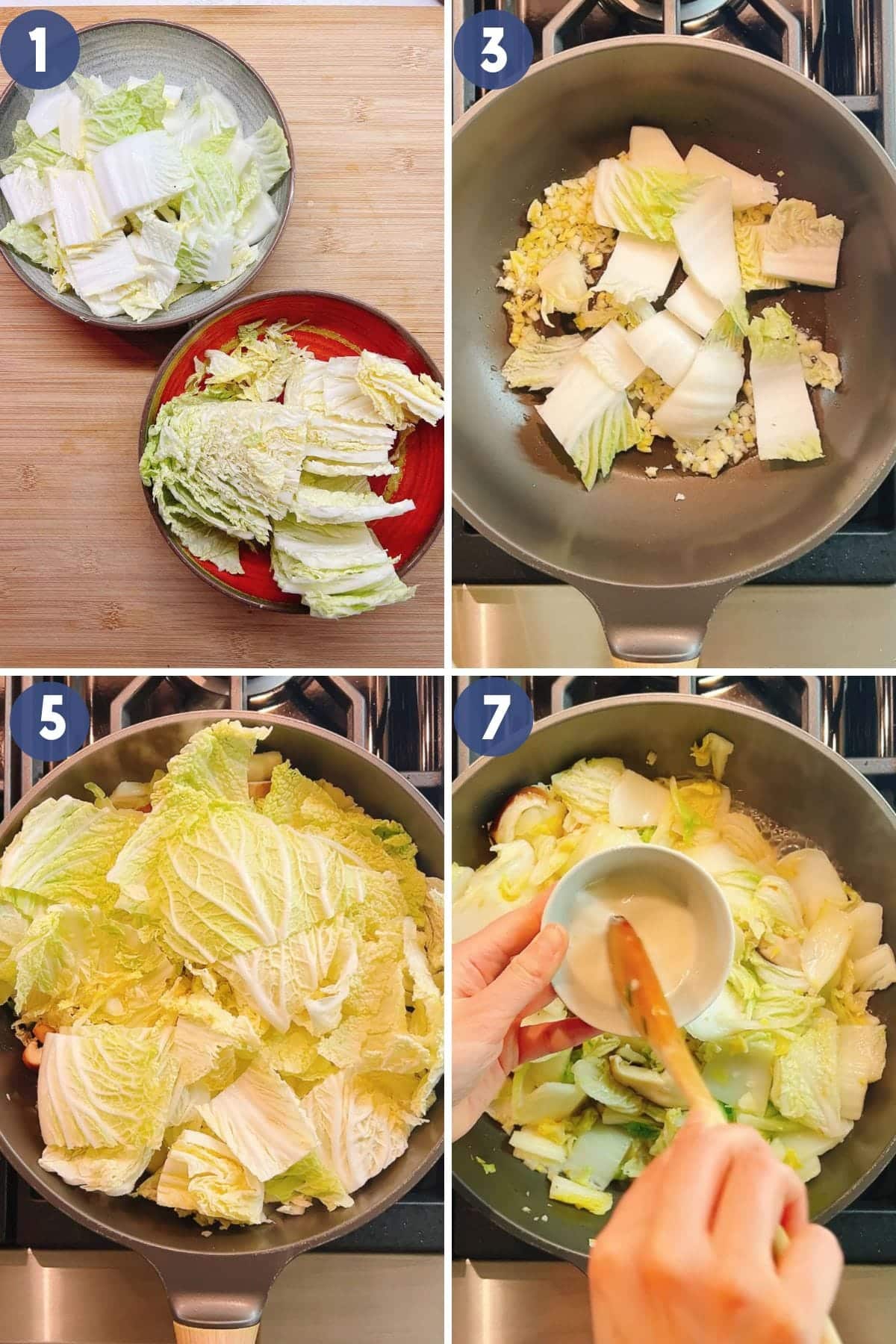
How to prepare napa cabbage
- Slice the Cabbage: Cut the Napa cabbage lengthwise into quarters, trimming away the core. Dice the stems into 1.5-inch pieces and the leaves into larger, 2.5-inch pieces. Learn more on how to cut napa cabbage.
- Rinse and Drain: Wash the stems and leaves separately to ensure they’re clean. Then, let them drain well to remove excess water.
How to cook napa cabbage
- Stir-Fry the Base: Heat a large pan or large skillet with 1.5 tablespoons of oil over medium heat. Add minced ginger and garlic, sautéing briefly for about 5 seconds.
- Add the Stems: Increase the heat to medium-high heat and add the cabbage stems, stir-frying for 1 minute before introducing the shiitake mushrooms and a bit of salt.
- Incorporate Leaves: Add the leafy parts of the cabbage to the pan, continuing to sauté until they start to soften and wilt.
How long to cook napa cabbage
- Total Cooking Time: After adding the stems, you’ll spend roughly 2 to 3 minutes cooking before adding the leaves, which then take an additional 1 to 1.5 minutes to reach the perfect tenderness.
- Finishing Touches: After the vegetables are cooked, stir in a tapioca starch slurry to thicken the sauce, cooking everything together for another minute before turning off the heat.
Tip: When cooking, remember that the stems need a bit more time than the leaves. Start with the stems to ensure they soften up just right, then introduce the leaves later on. Aim for tender textures without crossing into mushy territory.
More ways to use napa cabbage
Napa cabbage is a super versatile vegetable perfect for both raw and cooked dishes. It’s a fabulous, healthy choice for meals throughout the year. Here’s how to make the most of it:
What to make with Napa cabbage
- Soups and Stews: It’s a fantastic addition to soups and stews. Try it in an Instant Pot chicken Napa Cabbage soup, Napa cabbage egg drop soup, or add it to Chinese lion’s head meatballs for a comforting meal.
- Stir-Fried: Whip up a classic Chinese cabbage stir fry for a quick, flavorful side.
- Salads (raw): For a crunchy, fresh option, thinly slice the cabbage to create an Chinese chicken cabbage salad that’s bursting with flavor.
- Kimchi: Dive into fermenting with Gluten free kimchi or add a tangy twist to your meals with a Kimchi chicken stir fry.
- Wraps and Rolls: The large, pliable leaves of Napa cabbage make excellent wrappers for savory fillings after blanching. They offer a healthier alternative to bread or tortillas.
How to make-ahead, store, and reheat
With some smart prep and storage tips, here’s how you can get ahead of the game, keep your sauteed Napa cabbage recipe fresh.
- Make-ahead: Prep early by slicing the Napa cabbage 1-2 days before cooking. To keep it crisp and fresh, wait to rinse it until just before you’re ready to fire up the stove.
- Storage: After enjoying your meal, store any leftovers in an airtight container in the refrigerator. It’s best to enjoy it within 3 days for maximum freshness.
- Reheat: When you’re ready for round two, gently reheat the cabbage in a microwave on medium power. Stir it halfway through the reheating process to ensure it warms evenly.
What to serve with Napa vegetable
Sauteed Napa Chinese cabbage tastes light and refreshing. Whether you lean towards hearty grains or savory proteins, we’ve got you covered with these flavorful matches.
- Serve with rice and noodles: Pair the napa cabbage vegetable with the savory Cantonese chow mein, or opt for the hearty Steak fried rice. For a slightly chewy texture that’s absolutely delightful, Shanghai rice cake with napa cabbage and bok choy makes a wonderful addition.
- Protein pairings: Serve the stir fried Napa cabbage with Black pepper angus steak Panda Express offers a spicy kick that complements the cabbage nicely. For a lighter option, consider the Ground chicken stir fry with green beans or Miso ground pork stir fry. Or, if you’re in the mood for something crispy, the Air fryer salt and pepper tofu is a must-try.
Tips for success
- Vegetable Prep is Key: Remember to slice and separate the Napa cabbage stems from the leaves, as they have different cooking times. This ensures each part of the cabbage is perfectly tender.
- Monitor the Heat: Keeping your pan at the right temperature is crucial. The stems should sizzle as they hit the pan, a sign you’re on track to flavor town.
- Avoid Sogginess: Since Napa cabbage is juicy, drain it well after washing. Excess water can turn your stir-fry into a stew, losing that crisp texture we love.
- Flavor Boosters: Don’t shy away from bouillon powders or a dash of MSG if you’re comfortable with it. These can elevate the umami taste without overpowering the natural flavors of the vegetables.
- Stir-Fry in Stages: Add ingredients in stages according to their cooking times — start with the stems, then mushrooms, and finally the leaves. This technique preserves texture and flavor integrity.
- Thicken for Gloss: The tapioca starch slurry not only thickens the sauce but also gives your dish a glossy, appealing look. A quick final stir ensures everything is beautifully coated.
FAQs
Napa cabbage is more tender and cooks faster than regular cabbage. It’s best to cook it with a lighter touch and for a shorter duration to preserve its sweet, delicate flavor.
Napa cabbage can be stir-fried, added to soups and stews, used in salads, or made into kimchi. Its versatility makes it perfect for a variety of delicious, healthy dishes.
Yes, it’s important to wash Napa cabbage before cooking to remove dirt and pesticides. Separate the leaves for thorough cleaning, then drain well to avoid water logging the dish.
Cut Napa cabbage into quarters, remove the core, then slice into desired sizes. Start by stir-frying the stems, as they take longer, then add the leaves until just wilted.
More Asian recipes with Napa cabbage
If you love cooking Napa cabbage, you’re in for a treat! Each of these Napa cabbage dishes offers a unique way to enjoy this delicious Asian vegetable. I hope you’ll love them as much as I do.
- Stir Fried Napa Cabbage: A super simple vegetarian stir fry that brings out the sweetness of Napa cabbage with a colorful touch of carrots.
- Napa Cabbage Casserole: Dive into this Japanese-inspired casserole dish, where Napa cabbage is baked to perfection, offering a comforting and hearty meal.
- Napa Cabbage Slaw: An easy and refreshing salad with thinly sliced napa cabbage and crunchy toppings, tossed in a creamy Miso ginger dressing.
- Vegan Hot Pot: Featuring Napa cabbage as a must-have veggie, this hot pot is a vibrant, flavor-packed soup that’s both savory and sweet, perfect for warming up any mealtime.
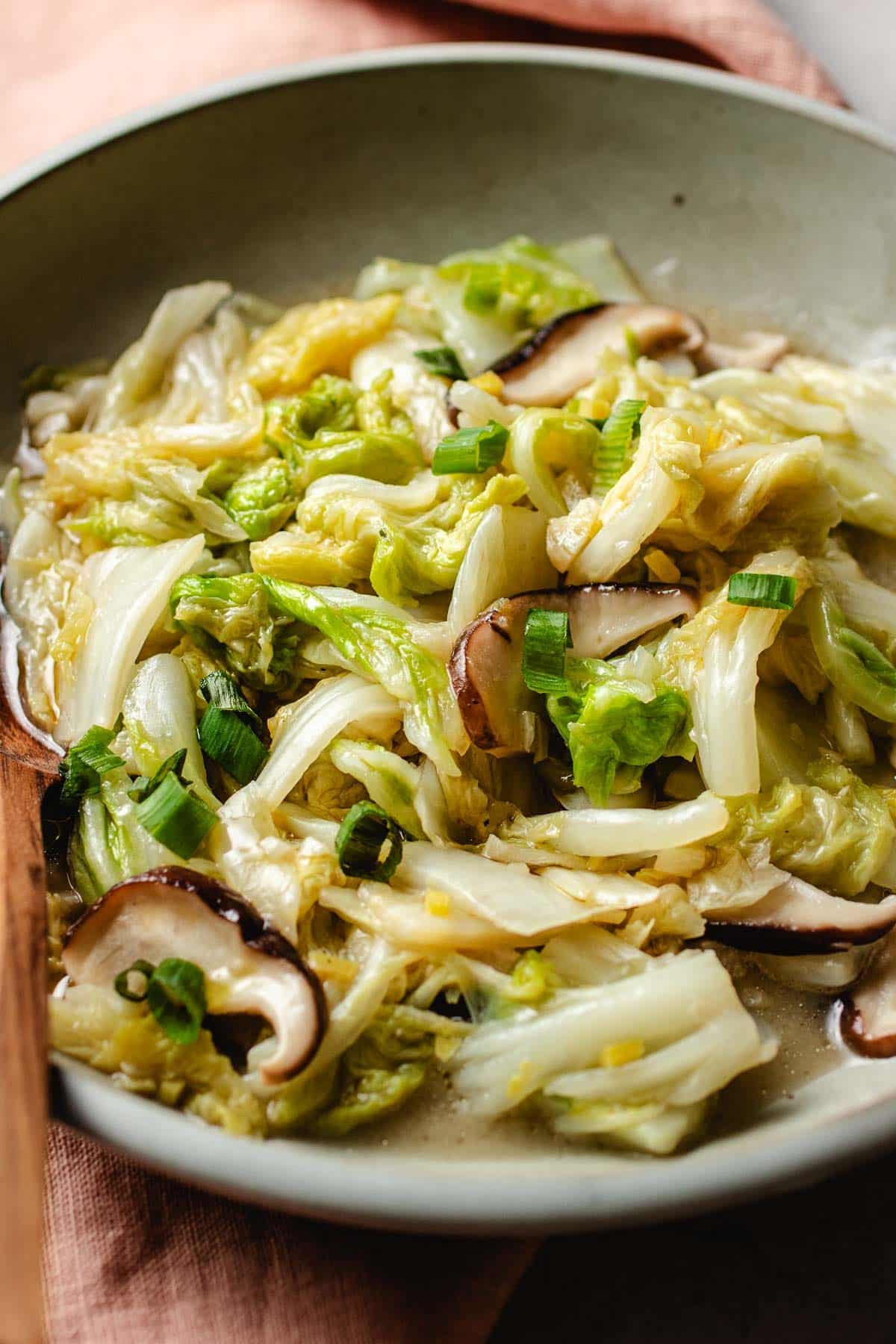
Sauteed Napa cabbage with shiitake recipe
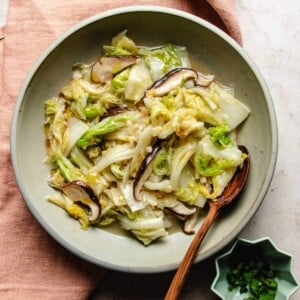
Video
Ingredients
- 25 oz napa cabbage half of one medium
- 0.2 oz ginger finely minced, half of one thumb
- 0.8 oz garlic finely minced, 4 large
- 4 oz shiitake mushrooms sliced, 4 large caps fresh or rehydrated dried shiitake
- 2 tsp tapioca starch
- 2 tbsp chicken stock or water
- 1.5 -2.5 tbsp avocado oil or olive oil
- ½+1/4 tsp coarse sea salt or to taste
- 1 tsp Takii shiitake mushroom seasoning or chicken bouillon, optional
- drizzle toasted sesame oil optional
Instructions
- Napa cabbage: Slice the napa cabbage lengthwise to halve the cabbage then slice each halve again to quarter it. Make a small angle cute to slice away the core. Dice the cabbage stems to about 1.5-inch (3.8 cm) sections and the leafy parts 2.5-inch (6 cm) sections. Rinse the stems and the leaves separately and set them aside to drain well.
- Aromatics: Prepare the ginger, garlic, and shiitake, and make a slurry by mixing the starch with chicken stock in a small bowl.
- Saute: In a large saute pan, 12-inch (30 cm) wide, preheat it over medium heat until it feels quite warm. Add 1.5 tbsp oil, swirl it around the pan, then add the ginger and garlic. Saute for 5 seconds then add the cabbage stems. Turn heat up to medium-high and stir-fry for 1 minute.
- Saute: Add the shiitake and ½ tsp salt. Saute for 1 minute, then add the leafy parts. Keep sauteing until the leaves turn slightly softer and wilted, about 1 to 1.5 minutes. Season with the remaining ¼ tsp salt and mushroom bouillon, if using. If your pan feels dry, you can add 1 more tablespoon of oil to help with the stir frying.
- Thicken: Stir the slurry again and pour it into the pan. Continue scooping and tossing for 1 more minute for the liquid to thicken, then turn off the heat.
- Serve: Drizzle with toasted sesame oil. Taste and adjust with more salt, if needed. Serve warm or at room temperature.
Notes
- Prep Your Veggies: Rinse and drain Napa cabbage well to avoid adding extra water to your stir-fry. Separate stems and leaves for easier cooking—stems first, leaves later.
- Master the Stir-Fry: Keep your pan hot enough to sizzle but watch the timing to avoid overcooking. Aim for tender stems and wilted leaves. A large wok or Dutch oven is ideal.
- Mushroom Choices: Shiitake mushrooms add a woodsy flavor, but beech mushrooms are a great alternative for a different taste profile.
- Savor the Flavor: A light touch of garlic, ginger, and optional shiitake or chicken bouillon (or a dash of MSG) brings depth without overwhelming.
- Storage: Store unwashed Napa cabbage in the fridge wrapped in food wrap for 4-5 days. Avoid freezing to prevent freezer burn.
Nutrition
Nutrition information is automatically calculated, so should only be used as an approximation.
Made a dish and loved it? Please remember to rate the recipe and leave a comment in the section below! It helps my blog grow organically, allowing me to continue sharing free and awesome content with you. Thank you!


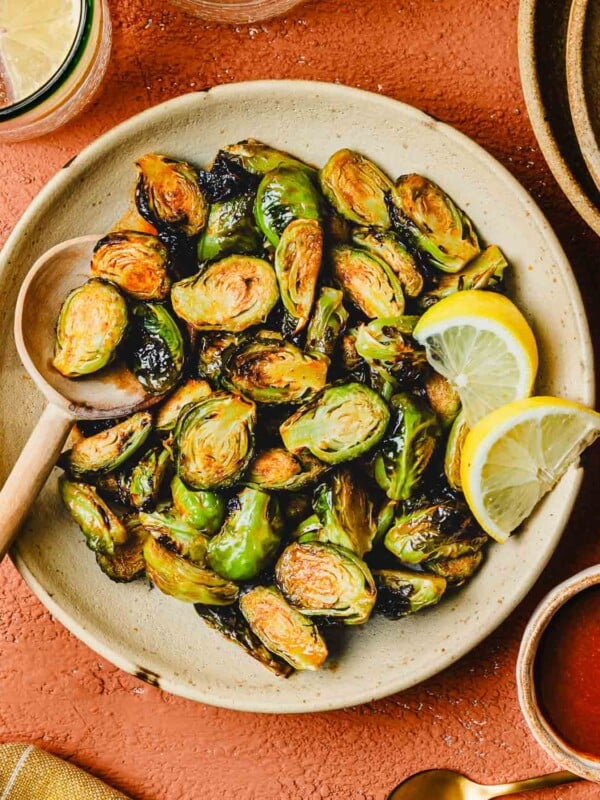
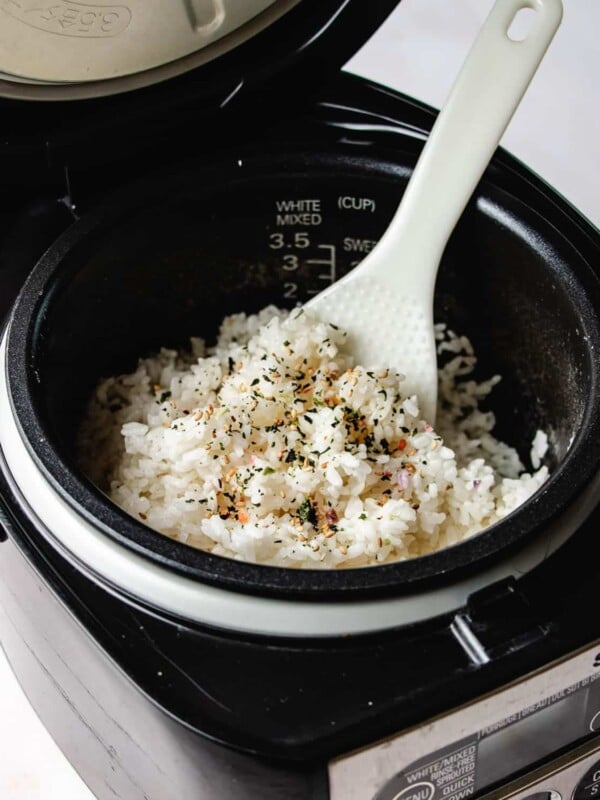









Another amazing recipe, Chihyu!! Super easy and fast yet tastes like it came from a restaurant! Will definitely make again and again! Love your recipes!!
Thank you so much! I appreciate it! 😀